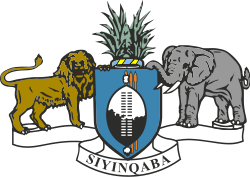This article needs additional citations for verification .(March 2025) |
 |
|---|
This article lists the monarchs ( Ngwenyamas ) of Eswatini (known as Swaziland for most of its history).
Contents
- Ancient Kings / Chiefs of the Swazi people (pre–1720)
- Kings of Swaziland (1720–1906)
- Paramount Chiefs of the Swaziland Protectorate (1906–1968)
- Kings of Swaziland / Eswatini (1968–present)
- Timeline
- Queen Mothers of Swaziland / Eswatini (1745–present)
- Royal Standard
- See also
- References
- External links
The King of Eswatini (also known as Ingwenyama) rules alongside the Queen Mother (also known as Ndlovukati ). The role of the king has historically been as the head or father of the nation while the Queen Mother is the spiritual leader of the nation. [1]



